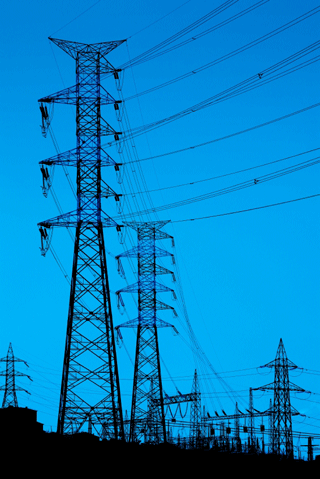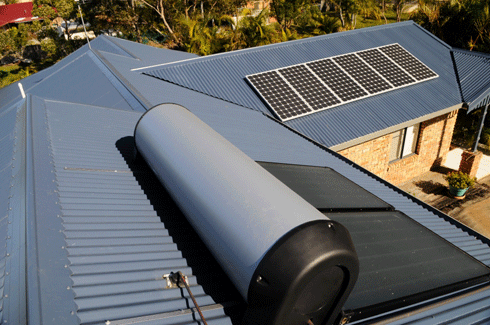
|
Published: 4 July 2011
Assessing domestic electricity price rises
Australian household electricity prices have been rising at rates that outpace those in other advanced economies since at least 2007. The latest Climate Change Review report illuminates key drivers of rising domestic prices, and improves our understanding of the potential effects of carbon pricing.

|
|
Rising network costs are key to understanding recent increases in the cost of electricity in Australian households. Credit: iStockphoto
|
Transforming the Electricity Sector, the eighth update to Professor Ross Garnaut’s Climate Change Review, was published in March 2011. The report begins with an unequivocal assertion that from 2007 to 2010, electricity prices for households rose by 32 per cent in real terms: ‘well ahead of the general increase in prices and faster than growth in average wages’. What has driven this rise?
Funding network costs
Prof. Garnaut says that network costs – the costs of maintaining and upgrading the towers, poles and wires that transport electricity to customers – are the ‘single largest cause of recent electricity price rises’, and account for approximately 68 per cent of recent price rises. This is a position shared by stakeholders as diverse as the Clean Energy Council of Australia and the Energy Supply Association of Australia (ESAA) – the peak industry body in Australia for retail, supply and generation of electricity and natural gas.1
According to Prof. Garnaut, most of the network cost rise is due to distribution rather than transmission. Distribution is the lower-voltage wiring that brings power from substations to consumers, whereas transmission refers to the extremely high-voltage metal towers connecting generators to substations. Transforming the Electricity Sector reports that this cost trend looks set to continue.
Key to rising network costs has been the need to service increasing numbers of customer connections arising from population growth. This is exacerbated by the trend towards fewer numbers of people per household.2 Prof. Garnaut also points to the continued growth of average household energy demand as another driver. A recent slowdown – possibly from increased energy efficiency measures and use of solar power – has not been enough to reverse the trend. The report reveals that energy consumption associated with electrical appliance use, for example, is increasing at a rate of approximately five per cent a year.
Professor Gerard Ledwich of the Queensland University of Technology believes that Prof. Garnaut has not placed enough emphasis on the relationship between increased use of household energy-intensive appliances and peak demand growth as a factor in increasing network costs.
‘Growth in the order of 13 per cent or more per annum in peak load is driving a substantial investment in network build,’ he says. ‘This peak load is mainly coming from domestic air conditioners. It means that on the hottest day of the year, there is a sudden massive increase in load, and the network has to be built to meet the peak load, even though those air conditioners may only be on one day of the year.’
This growth in peak load is common across all states, but is acute in the southeast corner of Queensland. As Mr Brad Page, CEO of the ESAA explains, this is due to strong population growth combined with changes in house design.
‘The traditional Queenslander design, on stilts and with a wide encircling verandah, was suited to the climate,’ he says. ‘Today’s houses tend to be on concrete slabs with no verandahs, shallow roofs and small eaves. So the answer to cooling becomes to put in air conditioners, which tend to get switched on somewhere round 3:00–4:00 pm in summer and go off at 8:00–9:00 pm.’
Mr Page also points to the use of flat-screen TVs. ‘[These] are more energy hungry than the old cathode ray tube displays, and are coincident in their use with air conditioners,’ he says.

|
|
Government subsidies for small-scale renewable technologies such as solar power have contributed to rising domestic electricity costs. Credit: iStockphoto
|
Experts have been warning for some time of major price impacts from unbridled consumer peak demand outstripping supply capability.3 It is very costly to build infrastructure just to meet spikes in peak demand, such as on random hot days. Prof. Garnaut argues that in Australia, unlike other developed countries, there has been little effort to change consumer behaviour – known as demand-side management – to discourage peak usage of power through such measures as design policy, differential pricing, smart meters or smart grids (see the story on smart grids in this issue of Ecos).
Mr Page says the domestic energy future for Australian consumers may, therefore, increasingly involve technology that allows them to be more active in their decisions around consumption. ‘[For example], you could use a smart phone to remotely cycle your air conditioner differently so that it doesn’t use as much energy when you’re not at home,’ he suggests.
In relation to differential pricing, Mr Page believes that historically, governments have been unwilling to move in this direction, and that leadership on this issue is required.
Replacement of ageing infrastructure is another factor in the network component of recent price rises. As Mr Page points out, the network in Victoria and New South Wales, for example, ‘was built between the 1950s and 70s and many of its parts are reaching the end of their useful life’.
Other components of rising network costs are the higher reliability standards for distribution demanded by some states, which require additional capital investment by the network businesses. The technical complexity of increasing domestic and industrial renewable energy feed-in to the grid also requires investment adjustment.
Wholesale and retail costs
After increasing network costs, wholesale cost price rises – the price of generating the power – make up 19 per cent of recent domestic price increases.
While increased demand, particularly peak demand, is largely responsible, the large-scale renewables component of the renewable energy target (LRET)4 is also a component. A 2011 report by ROAM Consulting (the ROAM report), which was commissioned by the Clean Energy Council, estimates that by 2020, the LRET will cost between $48 and $68 per household per annum, with the final figure being affected to some extent by a carbon price.
Finally, Prof. Garnaut estimates that 14 per cent of the overall price increase is due to customer retail service and related costs. This includes the operating costs of retail power businesses such as IT systems, billing, marketing and call centres, and their margins, typically constituting 4–7 per cent of retail tariffs.
Carbon price effect on bills
Assessments of the relative impact of carbon pricing on domestic electricity prices vary widely. The ROAM report maps percentage increase in total retail costs against two different carbon price settings: the first targets a 5 per cent emissions reduction (referred to as a –5 per cent carbon price trajectory); the second targets a 15 per cent emissions reduction (referred to as a –15 per cent carbon price trajectory). The report concludes that ‘although wholesale electricity prices increase by a relatively large amount when carbon pricing is introduced, wholesale electricity costs constitute a relatively small proportion of total retail costs. Therefore the percentage increase in total retail costs due to carbon pricing is relatively small. In 2014 costs increase 9 per cent to 12 per cent in the case of a –5 per cent carbon price trajectory, or 13 per cent to 17 per cent in the case of a –15 per cent carbon price trajectory. In 2020 total retail costs increase 11 per cent to 18 per cent in the case of a –5 per cent carbon price trajectory, or 16 per cent to 24 per cent in the case of a –15 per cent carbon price trajectory.’
The electricity supply industry is not so sanguine. Mr Page says that ‘network costs are “lumpy”: while they may jump suddenly, they then ease off again after the big investments have been made. Carbon pricing is not like that; it will increase faster than CPI for as far into the future as can be seen, even during fixed-pricing of carbon, and so it becomes a larger and larger impost year on year.’
Like the Clean Energy Council, Prof. Garnaut believes that the increase in electricity prices that will be attributable to carbon pricing will be relatively small compared to other price-increase drivers. However, he warns that low-income households that spend a higher proportion of their income on electricity will be disproportionately affected. Prof Garnaut has recommended that carbon tax revenues support those households.
Given the complexity of Australia’s multi-state energy supply network, analysis of the eventual impact of carbon pricing on electricity bills will continue. The average consumer must, for now, adapt: hoping their higher charges result in both sustainable peak demand infrastructure and stricter demand side management processes. A positive is that consumers have little choice but to be more energy – and carbon – efficient.
More information
Professor Ross Garnaut, Transforming the electricity sector, Climate Change Review Update 8, tinyurl.com/garnaut-review8
1 ROAM Consulting for the Clean Energy Council of Australia, Impact of renewable energy and carbon pricing policies on retail electricity price, March 2011. tinyurl.com/3r227ar
2 Australian Bureau of Agricultural and Resource Economics, Energy in Australia 2010. tinyurl.com/3bp979e
3 For example see: tinyurl.com/energy-response
4 The legislated mandatory renewable energy target requires electricity retailers to source 20 per cent of total electricity sales from renewable energy sources by 2020. The LRET component is the portion attributed to supply from large-scale renewable generation facilities.



